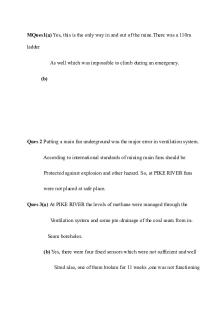Mechanical ventilation CM PDF

| Title | Mechanical ventilation CM |
|---|---|
| Author | Marjan Davoudabadi |
| Course | med surg |
| Institution | Chamberlain University |
| Pages | 2 |
| File Size | 96.2 KB |
| File Type | |
| Total Downloads | 20 |
| Total Views | 139 |
Summary
Download Mechanical ventilation CM PDF
Description
NURS3301 Concept Map DISEASE: Patient receiving mechanical ventilation
CLINICAL MANIFESTATIONS:
LABS/ DIAGNOSTICS/ TESTS:
Name:________________________________________
Date:____________
ETIOLOGY:
ASSESSMENT:
-assess coping with mechanical ventilation -respiratory assessment: - vital signs, respiratory rate and pattern, breath sounds, evaluation of spontaneous ventilator effort, potential evidence of hypoxia (i.e skin color), increased adventitious breath sounds (need for suctioning) -nurse evaluates settings and functioning of mechanical ventilator -assess neurologic status -assess lung sounds every 2-4 hours -assess GI system and nutritional status because weaning requires adequate nutrition -assess ABG’s.
MEDICAL MANAGEMENT:
MEDICATIONS:
NURSING INTERVENTIONS: pg 531
NURSING DIAGNOSES:
-impaired gas exchange -ineffective airway clearance -risk for trauma and infection -impaired physical mobility -impaired verbal communication
- keep patients head 30 degrees or higher to prevent aspiration and VAP -enhancing gas exchange - promoting effective airway clearance -preventing trauma & infection -promoting optimal level of mobility -promoting optimal communication -promoting coping ability -monitoring potential complications -promoting home based, transitional care
PATIENT EDUCATION:
NURS3301 Concept Map
Name:________________________________________
Date:____________
Nursing Interventions enhancing gas exchange promoting effective airway clearance preventing trauma & infection promoting optimal level of mobility promoting optimal communication promoting coping ability monitoring potential complications promoting home based, transitional care Potential complications Alterations in cardiac function o Can occur due to positive pressure ventilation, the positive intrathoracic pressure compresses the heart and great vessels = reducing venous return and cardiac output o Observe for signs of hypoxia: restlessness, apprehension, confusion, tachycardia, tachypnea, pallor progressing to cyanosis, diaphoresis, transient hypertension, decreased urine output Barotrauma and pneumothorax o Excessive positive pressure can cause laung damage (barotrauma) = spontaneous pneumothorax, which can quickly develop into tension pneumothorax. Assess for sudden changes in O2 stat. Pulmonary infection o High risk for infection! Report fever, change in color or odor of sputum o Patients that are going to be intubated for longer than 72 hours will benefit from endotracheal tube with subglottic suction port. Delirium o ABDE bundle A: awakening Breathing Coordination Delirium monitoring and management Early mobility Goal of this bundle is to improve communication among members of health care team, standardize care related to assessment and use of sedation, provide nonpharmacologic interventions in management of delirium and provide early exercise and ambulation...
Similar Free PDFs

Mechanical ventilation CM
- 2 Pages

Mechanical-ventilation
- 2 Pages

CM
- 16 Pages

Ques1 - ventilation system
- 2 Pages

Syllabus Mechanical
- 2 Pages

Mechanical assignment
- 1 Pages

Mechanical mice
- 8 Pages

Mechanical Vibrations
- 1 Pages

Mechanical-Textbooks
- 3 Pages

Mechanical Seal.pdf
- 5 Pages

Mechanical-engineering
- 1 Pages

Mechanical metallurgy
- 10 Pages

Mechanical engineering
- 1 Pages
Popular Institutions
- Tinajero National High School - Annex
- Politeknik Caltex Riau
- Yokohama City University
- SGT University
- University of Al-Qadisiyah
- Divine Word College of Vigan
- Techniek College Rotterdam
- Universidade de Santiago
- Universiti Teknologi MARA Cawangan Johor Kampus Pasir Gudang
- Poltekkes Kemenkes Yogyakarta
- Baguio City National High School
- Colegio san marcos
- preparatoria uno
- Centro de Bachillerato Tecnológico Industrial y de Servicios No. 107
- Dalian Maritime University
- Quang Trung Secondary School
- Colegio Tecnológico en Informática
- Corporación Regional de Educación Superior
- Grupo CEDVA
- Dar Al Uloom University
- Centro de Estudios Preuniversitarios de la Universidad Nacional de Ingeniería
- 上智大学
- Aakash International School, Nuna Majara
- San Felipe Neri Catholic School
- Kang Chiao International School - New Taipei City
- Misamis Occidental National High School
- Institución Educativa Escuela Normal Juan Ladrilleros
- Kolehiyo ng Pantukan
- Batanes State College
- Instituto Continental
- Sekolah Menengah Kejuruan Kesehatan Kaltara (Tarakan)
- Colegio de La Inmaculada Concepcion - Cebu


